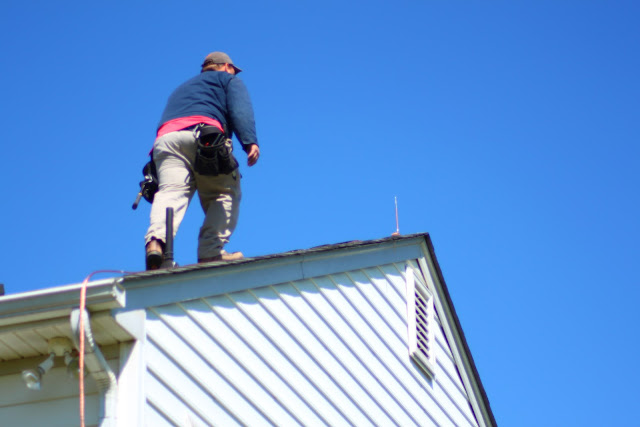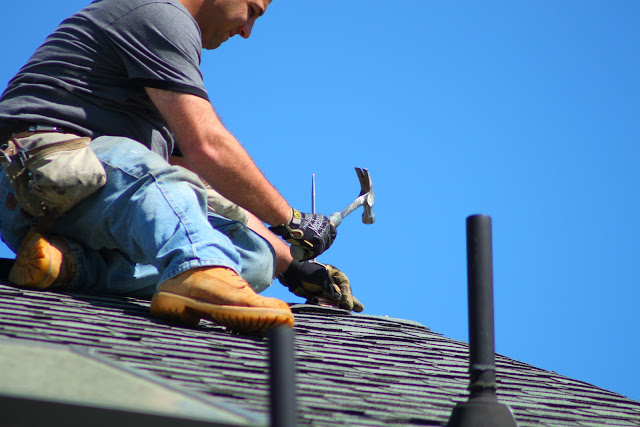 |
| The contractors placing lightning rods on our main barn, and grounding cable while navigating the complexities of doing so with a cupola with weather vane or two. |
On Friday the contractors who specialize in preventing lightning damage to homes, barns, garages, outbuildings and trees arrived. Prior to this, we had been doing research and conversing with a variety of internet companies. My husband is an electrical engineer and we had believed that his know how, coupled with the companies on the internet who sell lightning rods and grounding equipment might enable us to do the job ourselves. Most everyone in the US, and at this point, most of the world, is looking for ways to save money when they can. We completed our own research recently and decided to go with a reputable Virginia company who does nothing but lightning protection, who has been in continuous business since 1947.
 |
| I don't think I could ever be this relaxed or comfortable walking on roofing. |
Had this been simply our home, then we quite possibly would have hired someone with this expertise to draw us the plan and list the materials, and then do this ourselves, but for many reasons, this was a complex project. We have already had numerous lightning strikes in oak trees over the time in which we have owned this property. We sustained an outbuilding strike last year in which one of our sons who was inside was injured, and is still being treated. Also, for some reason, last years lightning appears more severe than prior years. As much as we did not wish to spend the money, good lightning protection was becoming a more important objective than it had been. In addition, the sheer size of the job is daunting. We need to provide lightning protection to the main house, a large two story barn, a two story workshop building, a kennel building, and a two story gambreled building. All of the outbuildings have steel roofing. We have one more building currently occupied by alpacas, but they are being relocated to an agricultural building shortly, leaving the one story barn for ducks. We do not have plans to provide lightning protection for the solar powered duck house, because it's location is such that it likely does not require it. Friday, a fair number of men arrived to do the job including a foreman and a project manager. They evaluated the location of the buildings and also of the breaker boxes in each location. One team began assembling ladders to access the first building. The project manager and my son and I were discussing the project and the location of trees we felt should be protected from lightning also due to their proximity to buildings and history of near strikes. Before we had completed our discussion, the first team had placed lightning rods on the building with the sharpest roof pitch. The second team began setting up ladders and measuring custom copper braided rope for the two story barn. This was a complicated job because the roof lines to each outbuilding are different. When having them built, we believed that we were creating architectural interest, and although that may be true, it also creates challenges in terms of lightning protection. Each structure required placement of rods and grounding ropes in a slightly different manner. Fairly quickly, two of the buildings were nearly complete. I was amazed to watch a fifteen to twenty foot or so copper grounding rod being buried on both sides of each building for proper grounding. They used power equipment in order to in effect, jackhammer the rods into our rocky soil. Then, someone proceeded to place a custom made lightning arrestor in our main barn's breaker box. Afterward, one team began to work on the two story gambreled building while another broke off to start the main house. I did not realize until the main house that when the copper grounding braid is attached to the six foot copper rod at each building, than they are in fact welded to each other rather than simply linked via a clamp of some kind which could disconnect in the event of flooding, earthquakes or even landscaping in the area. By this time, it was lunchtime. The teams were staying through lunch and when complete, would be going home a little early. They completed our main house, and completed adding a custom arrestor to the breaker box in the main house also. The kennel was the last building to be done, and the dogs were oddly very quiet, probably figuring that these men apparently had our blessing and certainly seemed to know what they were doing.
 |
| Here, a fifteen to twenty foot copper ground is being essentially hammered into the hard ground. This way the copper grounding cable from the roof can be attached to it. |
There are three tall oaks that will be grounded by both an arborist and the project manager another day. Grounding trees, though necessary sometimes, as it is here, is complex and quite expensive. We lost a cherished eighty year old oak last year due to a massive strike, just a month before our son was injured by lightning in one of the buildings near the tree.
I don't think everyone needs professional lightning protection, but we certainly did. I think it was worth every dime we spent in terms of better protection this year from the thunderstorms which seem to be worsening in our area.
 |
| Mounting the lightning rods themselves turned out to be the easy part. |
 |
| Once the lightning rods are up, a custom braided copper braid is connected to them and then brought to the deep buried copper grounding rods. |
 | ||
| I don't know how they get up there ! That building is TWO stories. I get dizzy sometimes on my high heels. |
 |
| All of the men not only got the work done, and did it well, but they looked as if they were having fun while doing it. |
If you do need a professional lightning abatement contractor in another country, I am not sure how it is best to proceed. I would imagine taking your time to learn about lightning damage avoidance while asking trusted friends who they used would be the best strategy. Here is the US locating someone who knows what they are doing may be simpler. The Lightning Protection Institute keeps a page of contractors who are recognized to be competent. You can enter your state information here, and they will list contractors.
http://www.lightning.org/installers
They also refer Western Canadian families to:
http://westernlightningprotection.com/
Please visit their website. They have a heck of an introduction, as well as excellent information on lightning and the complex technologies employed in protecting buildings from its wrath.
Interestingly, lightning seems to be less of an issue in Nova Scotia and much of Atlantic Canada, because with so much water and lakes, lightning tends to strike there, and in most circumstances, is less of an issue than it is here. However, not everywhere borders water, and so if you are interested, this is information on lightning rod installation in Nova Scotia.
http://www.gov.ns.ca/lae/electricalsafety/esblightning.asp
These are links to brochures on lightning protection generally:
http://www.lightning.org/brochures-protection
Should you be in Virginia, we can pretty heartily recommend the lightning protection contractors we used. They were recommended to us by our pharmacist who happily used them, our barn builder who has used them and fully recommends their company, and also by the Lightning Protection Institute. They travel fairly far and wide, at least within our own state. Their contact information follows, and we thank them also for their willingness to allow us to photograph their employees at work for this blog post, and also for their willingness to let us use these photographs in this blog.
Loehr Lightning Protection Company
Joseph J. Loehr III,
5268 Hull Street Road
Richmond,
Virginia
23224
U.S.A.
(804) 272-1627
(804) 231-4239
Dealer/Contractor
(MID) Joseph J. Loehr III
(JI) Christopher E. Whitehurst
(JI) Joseph M. Moore


2 comments:
hi. thanks for the detailed description with pics. it was very helpful.Hope many find this post inspiring as useful.
Lightning Arrestors
Thanks. I thought this was one of the most important series I had done on this blog. Lightning is an incredible hazard to people and property in many places.
Post a Comment